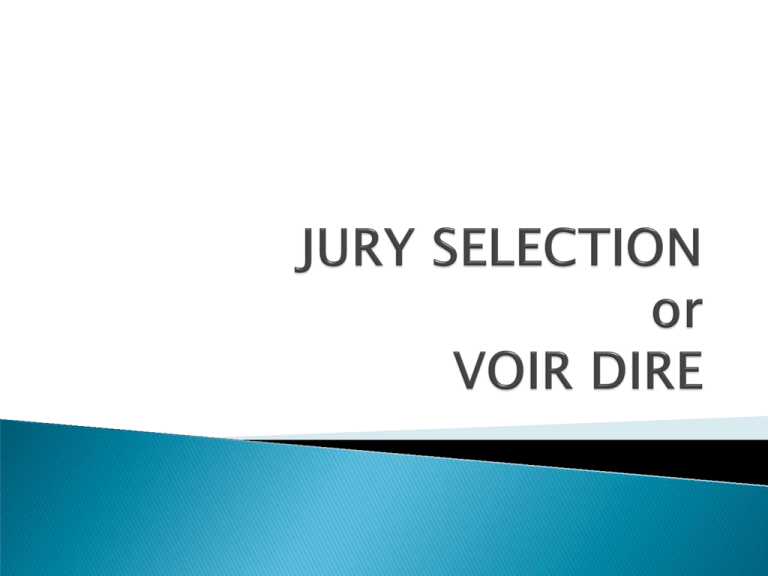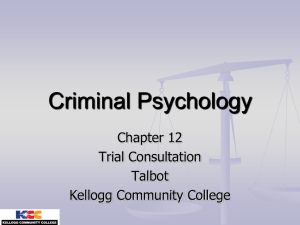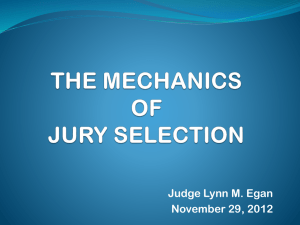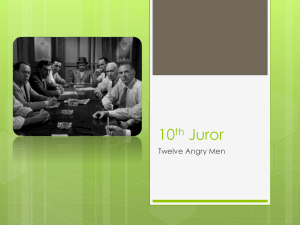Document 10852843
advertisement

Acquiring information about the panel members so as to be able to make challenges for cause and to exercise peremptory challenges Getting the panel to like you and your client (first time to talk = first impression of you and your client’s case for those eventually selected to serve Educating and persuading the panel on issue in case (although this has changed over the years) * Texas state court (Federal court very different) Questions to the panel to get the information* With information use: ◦ Challenges for cause ◦ Peremptory challenges For Cause Challenge – Juror responds to questions, or puts something in juror information card that shows they can’t be fair, i.e., bias/prejudice Peremptory Challenge – You just don’t like them * Federal Court – submit question and Judge does the talking Pecuniary interest in the case, employee of Plaintiff or Defendant, closely related to a party in the case Bias or prejudice re party Bias or prejudice re subject matter Test: ◦ The panel member cannot be fair and impartial because his or her feelings are so strong in favor of or against a party, or in favor of or against an issue, with respect to the subject matter, that the juror’s verdict will be based on these feelings and not on the evidence ◦ Because of past experiences or personal beliefs, a juror has such strong feelings on a subject that they would not be able to put aside their feelings to follow the judge’s instruction on the law Should be made orally as soon as counsel believes the grounds have been established for disqualification (but follow individual judge’s procedure) Whether done in open court or by approaching the bench is up to the judge Must be ruled on without delay In the discretion of the trial judge, can be rehabilitated by judge or opposing counsel Cortez v. HCCI-San Antonio, Inc., (Tex.2005) The court reasoned that there are no magic disqualifying words and potential jurors are not necessarily disqualified when they express bias. If a venire member expresses what appears to be bias, further questioning is permitted to show the opposite or at least clarify the statement. In addition, the Court reasoned that “an initial leaning is not disqualifying if it represents skepticism rather than an unshaken conviction.” If overruled, then must tell the court that: ◦ As a result of the court’s refusal to strike the for-cause panelist, the party will exhaust its peremptory challenges before striking an objectionable panelist on the list ◦ Identify the objectionable panelist* who will remain on the jury list once the party uses its last peremptory strike (the objectionable panelist can be either the panelist who should have been struck for cause or another objectionable panelist, and the objectionable panelist actually serves on the jury) * Tell judge the panelist has been identified, but ask judge to allow you to specifically identify after peremptory challenges are made, but before the jury is announced and seated. BATSON Can’t exercise peremptories on the basis of race or gender (some states also extend to religion and ethnic group) Procedure ◦ Opponent must make a prima facie case of purposeful discrimination by showing that other party used challenges to strike members of a protected class, and circumstances suggest exclusion occurred because of impermissible reasons. May be supported by statistical evidence and differences in questions asked. ◦ Proponent must provide race-neutral or genderneutral explanation. Doesn’t have to be persuasive or plausible. Just has to be permissible under the Equal Protection Clause ◦ Court must determine whether the opponent of the strike has proven purposeful discrimination. Will hold evidentiary hearing at which it may consider plausibility and persuasiveness of reason given. Need 24 panel members in District Court in two party case Each side has six peremptory challenges Need 12 panel members in County Court Each side has three peremptory challenges Multiparty case requires equalization One additional strike per side if one or two alternate jurors used, and two strikes per side if more than two Can only exercise against the alternates Make panel comfortable Professional/Sincere/Comfortable Eye contact Build rapport Different styles and goals of questioning: Have a system/Use a chart Know what type of juror you want and want off ◦ Commitment Style – make panel members promise you something, like not making decisions based on sympathy ◦ Attitudinal Questioning – “How do you feel about?” ◦ If you can, have associate or paralegal take notes 1. 2. 3. 4. Do use broad questions in order for litigants to discover any bias or prejudice – open ended to get information Do use hypos so long as they do not misstate the law Do ask, if you feel it is relevant, whether panel has heard or seen ads concerning jury verdicts and alleged liability insurance crisis Do ask, if relevant, about any connections between panel members and the insurance industry 1. 2. 3. 4. 5. 6. Don’t discuss specifics of your case Don’t ask questions that tell panel the legal effect of their answers to the jury charge Don’t ask about liability insurance in personal injury and wrongful death cases Don’t argue with a juror if they disagree with you – it is not cross-examination! Don’t ask to commit in advance as to the weight to be given certain evidence (should not really discuss specific evidence) Don’t call attention to differences in financial situation of the parties To preserve error there must be a record and objection Do not be afraid to object if needed Grounds ◦ Most common: asking juror to commit to certain decision if presented with certain evidence ◦ Objection: Improper Voir Dire





